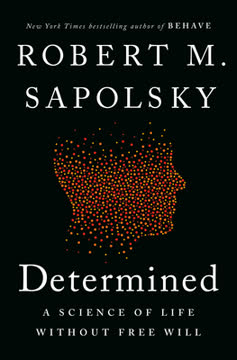重点摘要
1. DNA是塑造我们身份的主要力量
DNA是决定我们是谁的最重要因素。
天性胜过教养。 数十年的遗传研究通过双胞胎和收养研究一致表明,遗传的DNA差异占个体之间心理差异的约一半。这包括性格特征、心理健康、认知能力,甚至生活经历。遗传学的影响远远超过任何其他系统性影响,包括养育、教育和社会经济地位。
基因不是命运。 虽然DNA有深远的影响,但它并不决定我们的命运。遗传率描述的是现状,而不是可能性。环境因素仍然起着重要作用,占个体差异的另一半。然而,这些环境效应大多是无系统且不稳定的,使其难以研究或利用进行干预。
2. 遗传率占心理差异的约50%
我不知道有任何心理特征不受遗传影响。
普遍的遗传率。 迄今为止研究的每一种心理特征都显示出显著的遗传影响,通常占个体差异的约50%。这包括:
- 性格特征(如外向性、神经质)
- 心理健康障碍(如抑郁症、精神分裂症)
- 认知能力(如智力、记忆)
- 教育成果
- 生活经历(如压力事件、社会支持)
超越天性与教养。 各种特征的一致性遗传率发现已经转移了研究的焦点。科学家们现在研究基因和环境如何相互作用,基因效应如何随时间变化,以及如何利用遗传信息预测和潜在预防心理问题。
3. 环境影响大多无系统且不稳定
环境效应很重要,但近年来我们了解到它们大多是随机的——无系统且不稳定——这意味着我们对此无能为力。
挑战假设。 这一发现与长期以来关于共享家庭环境重要性的信念相矛盾。研究表明:
- 在同一个家庭中长大的兄弟姐妹与分开长大的兄弟姐妹一样不同
- 收养的兄弟姐妹在心理特征上几乎没有相似性
- 大多数环境影响是“非共享的”——每个人独特的
干预的影响。 环境效应的无系统性使得设计有效的干预措施具有挑战性。然而,这也意味着负面经历的长期影响可能比以前认为的要小,因为个体往往会回到其遗传轨迹。
4. 遗传效应随着年龄增长而变得更加显著
随着时间的推移,DNA变得更加重要。
遗传率增加。 研究表明,许多特征的遗传率,特别是认知能力,随着发展而增加:
- 智力:婴儿期20%,儿童期40%,成年期60%,65岁时80%
- 性格:相对稳定的遗传率约为40-50%
- 学校成绩:稳定的高遗传率约为60%
基因放大。 这种遗传率的增加可能是由于一种称为基因放大的过程。随着个体年龄的增长,他们越来越多地选择、修改和创造与其遗传倾向相匹配的环境。这导致了一个滚雪球效应,早期生活中的小遗传差异随着时间的推移而被放大。
5. 没有障碍,只有特征的维度
我们所谓的障碍只是正常分布中相同基因的极端表现。
重新思考精神病理学。 遗传研究挑战了传统的将精神障碍视为离散类别的医学模型。相反,障碍代表了存在于普通人群中的连续特征的极端。例如:
- 抑郁症:从很少抑郁到长期抑郁的连续体
- 精神分裂症:思维混乱和异常体验的光谱
- 多动症:注意力和活动水平在整个群体中的不同程度
对诊断和治疗的影响。 这种维度视角表明:
- 诊断阈值在某种程度上是任意的
- 治疗应侧重于缓解症状而不是“治愈”障碍
- 预防工作可以针对整个光谱上的个体,而不仅仅是那些符合诊断标准的人
6. 基因对多种特征有普遍影响
基因效应往往是普遍的而不是特定的,这就是为什么我称这个话题为普遍基因。
多效性在行动。 研究表明,许多相同的基因影响多种心理特征和障碍。这种现象被称为多效性,具有几个重要的影响:
- 一种障碍的遗传风险通常会带来其他障碍的风险(如精神分裂症和双相情感障碍)
- 认知能力共享大量的遗传重叠(如语言和空间技能)
- 影响正常变异的基因也影响极端分数或“障碍”
重新思考干预。 普遍基因的发现表明:
- 针对一种障碍的治疗可能对相关条件有益
- 广泛的干预措施可能比高度特定的方法更有效
- 理解特征的共享遗传基础可以导致更全面的心理功能模型
7. 兄弟姐妹因基因和独特经历而不同
我们知道兄弟姐妹在基因上有50%的相似性,这也意味着他们有50%的不同。
基因彩票。 兄弟姐妹从父母那里继承了不同的基因组合,即使在同一个家庭中也会导致显著差异。这种遗传变异,加上独特的环境经历,解释了为什么兄弟姐妹尽管共享同一个家庭环境却可以如此不同。
非共享环境。 研究表明,使兄弟姐妹不同的环境因素主要是:
- 无系统且不可预测的
- 每个人独特的(如不同的同伴群体、老师、生活事件)
- 随时间不稳定
这一发现挑战了养育或家庭环境对儿童结果有强烈系统性影响的观念,超出了他们提供的基因。
8. 养育和教育重要,但影响不大
父母重要,但他们没有影响。
重新思考影响。 虽然父母和学校在孩子的生活中无疑是重要的,但研究表明,除了遗传继承之外,它们对心理结果的系统性影响很小。这一反直觉的发现有几个影响:
- 养育方式对孩子的性格或能力影响很小
- 学校质量对学业成绩的差异解释不到2%
- 共享家庭环境对兄弟姐妹之间的相似性解释很少
对养育的新视角。 父母应:
- 提供一个支持性的环境,让孩子发现他们的遗传倾向
- 专注于建立关系而不是实现特定的发展目标
- 理解孩子的结果不是养育质量的反映
9. DNA差异创造了机会的不平等
结果的遗传率可以看作是机会平等的指数。
遗传精英主义。 随着社会变得更加精英主义并减少环境障碍,遗传差异在决定结果方面起着更大的作用。这导致了一些反直觉的结论:
- 像教育成就或收入这样的特征的高遗传率表明更大的机会平等
- 遗传差异促成了社会的上下流动
- 由于遗传变异,努力创造绝对的结果平等可能是徒劳的
伦理考虑。 认识到遗传不平等提出了重要的问题:
- 如何平衡精英主义与社会正义
- 社会在补偿遗传劣势方面的角色
- 遗传信息在选择过程中被滥用的潜在风险
10. 多基因评分正在革新心理预测
多基因评分基于DNA而不是水晶球,是预言家。
基于DNA的预测。 基因组研究的进展导致了多基因评分的发展,这些评分汇总了数千个基因变异的效应,以预测心理特征和结果。这些评分有几个独特的优势:
- 它们可以从出生开始预测,不像其他测量
- 它们的预测是因果的,而不仅仅是相关的
- 它们可以区分家庭成员
当前能力。 多基因评分已经可以预测:
- 7%的精神分裂症风险差异
- 11%的教育成就差异
- 17%的身高差异
随着基因研究样本量的增加,多基因评分的预测能力预计将显著提高。
11. DNA革命将改变临床心理学和社会
我们的未来是DNA。
范式转变。 从DNA预测心理特征和风险的能力将从根本上改变我们对待心理健康、教育和个人发展的方式。一些潜在的影响包括:
- 早期识别和预防心理问题
- 基于基因特征的个性化干预
- 重新思考个人责任和自由意志的概念
伦理挑战。 DNA革命也提出了重要的伦理问题:
- 如何平衡基因隐私与预测的潜在利益
- 在教育、就业和保险中的基因歧视风险
- “设计婴儿”和基因增强的潜在风险
随着我们进入这个新时代,进行关于遗传信息的影响及其如何负责任地为个人和社会利益使用的知情公众讨论至关重要。
最后更新日期:
FAQ
What's Blueprint: How DNA Makes Us Who We Are about?
- Focus on DNA's Role: The book explores how DNA significantly influences our psychological traits, accounting for about 50% of the differences among individuals.
- Nature vs. Nurture: It challenges the traditional view that nurture is the primary influence on behavior, arguing that genetic factors are the major source of psychological differences.
- Societal Implications: The author discusses how these findings affect parenting, education, and concepts of meritocracy and equal opportunity.
Why should I read Blueprint: How DNA Makes Us Who We Are?
- Groundbreaking Insights: The book presents cutting-edge research on the impact of genetics, essential for anyone interested in psychology, genetics, or personal development.
- Personal Relevance: It offers insights into understanding oneself and others, highlighting how genetic makeup shapes behaviors and life outcomes.
- Controversial Perspectives: Robert Plomin challenges conventional beliefs about parenting and education, prompting readers to rethink their views.
What are the key takeaways of Blueprint: How DNA Makes Us Who We Are?
- Genetics Matter Most: Genetic differences are the primary reason for psychological individuality, with environmental factors being less significant.
- Nature of Nurture: Environmental influences often reflect genetic predispositions, complicating the traditional understanding of nurture.
- Parenting and Education: The findings suggest that parents and schools have less impact on children's outcomes than commonly believed.
How does Robert Plomin define heritability in Blueprint: How DNA Makes Us Who We Are?
- Definition of Heritability: It is the proportion of variance in a trait attributed to genetic differences among individuals in a specific population.
- Not a Constant: Heritability can vary depending on the population and environmental context being studied.
- Key Concept: Understanding heritability clarifies the extent to which genetics influence psychological traits.
What is the "nature of nurture" concept discussed in Blueprint: How DNA Makes Us Who We Are?
- Genetic Influence on Environment: Genetic factors significantly shape our experiences and environments, rather than these environments solely influencing us.
- Correlations Explained: Correlations between environmental measures and psychological outcomes often reflect genetic influences.
- Implications for Psychology: This concept challenges traditional views, suggesting that understanding genetic contributions is crucial for interpreting environmental impacts.
How does Blueprint: How DNA Makes Us Who We Are address the differences among siblings?
- Sibling Differences Explained: Siblings raised in the same family can be quite different due to their genetic makeup, accounting for 50% of their psychological differences.
- Non-Shared Environment: Unique experiences that siblings do not share contribute to their differences.
- Genetic Similarity: Despite growing up together, siblings are only 50% genetically similar, leading to significant individual differences.
What are the implications of the findings for parenting, according to Blueprint: How DNA Makes Us Who We Are?
- Limited Impact of Parenting: Parents provide essential support, but their influence on children's psychological outcomes is minimal beyond genetic contributions.
- Focus on Genetic Traits: Parents are encouraged to recognize and nurture inherent traits rather than trying to mold specific outcomes.
- Relaxed Parenting Approach: Parents should enjoy their relationship with their children without excessive pressure to control development.
What does Blueprint: How DNA Makes Us Who We Are say about the role of schools in shaping children's outcomes?
- Minimal Impact of Schools: Schools have little effect on individual differences in academic achievement, as genetics plays a more significant role.
- Shared Environmental Influence: The shared environment accounts for only a small portion of variance in student performance.
- Supportive Environments: Schools should foster learning rather than focus solely on improving test scores.
What is a polygenic score as defined in Blueprint: How DNA Makes Us Who We Are?
- Composite Genetic Index: A polygenic score aggregates the effects of many genetic variants associated with a trait.
- Predictive Power: These scores can predict psychological traits by combining the effects of thousands of SNPs.
- Application in Personal Genomics: Polygenic scores help individuals understand their genetic risks and strengths.
How does Blueprint: How DNA Makes Us Who We Are address the nature vs. nurture debate?
- Genetics as a Primary Factor: Genetics is the most significant factor in determining psychological traits, often overshadowing environmental influences.
- Environmental Influences are Often Genetic: Many environmental effects have a genetic basis, challenging the simplistic nature versus nurture dichotomy.
- Implications for Understanding Behavior: Emphasizing genetics can lead to more effective interventions and a better understanding of individual differences.
What are the implications of polygenic scores for mental health according to Blueprint: How DNA Makes Us Who We Are?
- Predictive Potential: Polygenic scores can help predict an individual's risk for psychological disorders, enabling earlier interventions.
- Understanding Genetic Risk: Knowing one's polygenic score provides insights into mental health risks, allowing proactive management.
- Shifting Focus to Prevention: Using polygenic scores to identify at-risk individuals could revolutionize mental health care by focusing on early intervention.
What are the best quotes from Blueprint: How DNA Makes Us Who We Are and what do they mean?
- "DNA is the blueprint for who we are.": Emphasizes the foundational role of genetics in shaping psychological traits and individuality.
- "The abnormal is normal.": Suggests psychological disorders exist on a continuum with normal traits, challenging traditional diagnostic categories.
- "Parents matter, but they don’t make a difference.": Reflects the argument that while parents play a crucial role, their influence is largely mediated by genetics.
评论
蓝图:DNA如何决定我们的身份由罗伯特·普洛明撰写,提供了有力的证据表明基因在心理特征和行为上具有显著影响。普洛明认为,DNA占个体差异的约50%,环境因素的作用较小。书中讨论了双胞胎研究、多基因评分以及对教育和心理健康的影响。尽管一些读者认为普洛明的解释具有争议性,但许多人称赞该书对复杂遗传概念的清晰解释。批评者指出,该书可能简化了环境影响,并缺乏对基因-环境相互作用的讨论。
Similar Books












